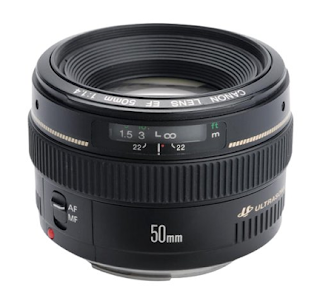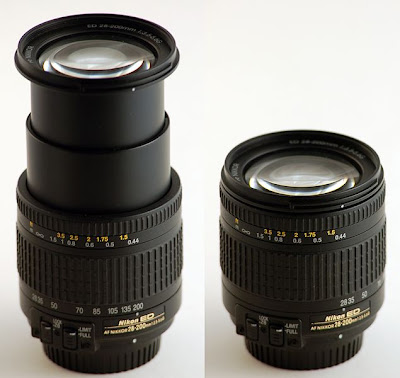Types of lenses:
Macro
Fish eye
Wide angle
We can get images of great realism with much depth of field.
Example: If we get a photo of a building from a corner and from the bottom it seems taller and longer that it really is.
Regular
Telephoto
They have a viewing angle of 30º or less and a focal length from 70 mm onwards.
Example: Bokeh effect with all blurry unless the person.
Summary:
From the same position lenses with wide angle can capture more space and the objects are smaller, while lenses with narrow angle can capture less space but the objects are bigger.
Wide angle lenses emphasize the perspective. Narrow angle lenses compress the space, things seem to be near each other that in reality are.
Narrow angle lenses are nice for portraits and wide angle lenses are nice for landscape.
Beware:
In portraits wide angle lenses make the nose bigger, narrow angle lenses make it smaller.
They used to be of lower quality than fixed lenses but now the quality is quite similar.
IS / AF lenses:
IS lenses:
The lenses with stabilizer (IS) can lower the risk of motion blur. We can use a slower shutter speed without tripod, this means higher image quality and more freedom of movement.
Macro
They are used to be able to photograph objects from very close. We can focus at a distance from 1 cm of the lens.
Fish eye
They have the greater viewing angle, they can reach 180º or more. Its focal length is usually between 6 and 16 mm.
They have many distortions in straight lines so the image appears whirring.
Wide angle
They have a viewing angle ranging from 180 º to 63 º. Its focal length is usually between 18 and 35 mm.
There are also distortions in the straight lines that can be more or less accentuated depending on the quality of the lens and the angle of view.
We can get images of great realism with much depth of field.
In these and in the fish eyes the more closer the more distorted the object will be.
Note of interest:
Objects appear smaller in proportion to the width of the viewing angle, so that emphasize perspective.
We can make near objects appear larger simply putting the lens near them, while the most distant objects still would seem smaller.
Objects appear smaller in proportion to the width of the viewing angle, so that emphasize perspective.
We can make near objects appear larger simply putting the lens near them, while the most distant objects still would seem smaller.
Example: If we get a photo of a building from a corner and from the bottom it seems taller and longer that it really is.
Regular
They have a viewing angle very similar to human eye (45 º). Its focal length is 50 mm usually.
They are the most luminous and they haven´t any distortion.
Telephoto
They have a viewing angle of 30º or less and a focal length from 70 mm onwards.
They compress the levels and sometime they are unrealistic because the distances between objects are reduced considerably.
Note of
interest:
For portraits one of the features of this lens is the ability to make selective focus. We can show the sharp face on a blurry and out of focus background (bokeh effect), in this way we will put the attention on the face. For that we can use focal length from 70 to 135 mm. More distance would be for distant photos.
For portraits one of the features of this lens is the ability to make selective focus. We can show the sharp face on a blurry and out of focus background (bokeh effect), in this way we will put the attention on the face. For that we can use focal length from 70 to 135 mm. More distance would be for distant photos.
Example: Bokeh effect with all blurry unless the person.
Summary:
From the same position lenses with wide angle can capture more space and the objects are smaller, while lenses with narrow angle can capture less space but the objects are bigger.
Wide angle lenses emphasize the perspective. Narrow angle lenses compress the space, things seem to be near each other that in reality are.
Narrow angle lenses are nice for portraits and wide angle lenses are nice for landscape.
Beware:
In portraits wide angle lenses make the nose bigger, narrow angle lenses make it smaller.
There are lenses that focus better in the middle, in this case we must avoid making compositions always around the center. One trick, we have to focus in the center and the use the AF-LOCK (focus lock). To learn about how to use the AF-LOCK the best way is to look the instructions of each camera.
They used to be of lower quality than fixed lenses but now the quality is quite similar.
IS / AF lenses:
IS lenses:
The lenses with stabilizer (IS) can lower the risk of motion blur. We can use a slower shutter speed without tripod, this means higher image quality and more freedom of movement.
AF lenses:
These lenses have auto-focus. The lens focus automatically.
Not always be convenient tu use the AF, sometimes we get better results with manual focus (MF) because there are surfaces that are not easy for the AF. In these situations we must to change from AF mode to MF mode (there is a button on the lens).
Beware:
The AF does not focus well on white surfaces, shiny and reflective objects, one trick is to focus around these surfaces, taking care that the distance between this new point is similar to the distance between the subject and the camera.
These lenses have auto-focus. The lens focus automatically.
Not always be convenient tu use the AF, sometimes we get better results with manual focus (MF) because there are surfaces that are not easy for the AF. In these situations we must to change from AF mode to MF mode (there is a button on the lens).
Beware:
The AF does not focus well on white surfaces, shiny and reflective objects, one trick is to focus around these surfaces, taking care that the distance between this new point is similar to the distance between the subject and the camera.














No hay comentarios:
Publicar un comentario